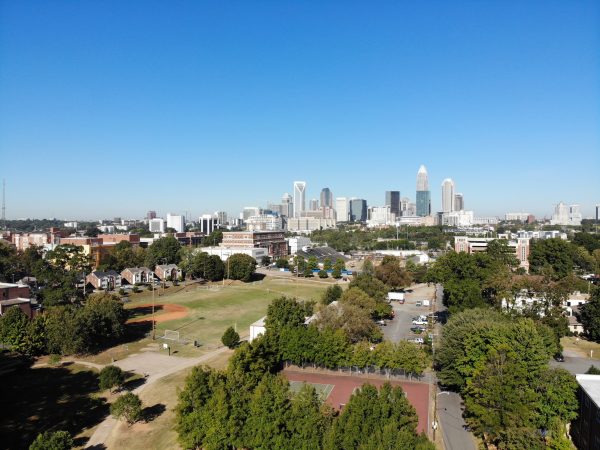Does regionalism still make sense in the era of the ‘Nation City’?

This is the first in a series of articles that will periodically explore regionalism, interconnectedness and other issues examined in the institute’s Carolinas Urban-Rural Connection report, published in fall 2019.
We are living in the age of the “metropolitan revolution” in the U.S.: the city as the crucible of change in the wake of waning effectiveness at the national level. Or so say some, like former Chicago mayor Rahm Emanual, whose book “The Nation City: Why Mayors Are Now Running The World” came out in February.
That the triumph of the city could now seem almost blasé to urbanists makes it all the more provocative to regionalists and rural advocates. We asked former UNC Charlotte Urban Institute Senior Fellow Brian Dabson, a nationally recognized expert on regional development and resilience, to give us his take on the new book, and the future of regionalism. Below he shares why he thinks cities (still) need their regions, whether the urban-rural divide narrative will wither away in 2020 and how this new era of pandemic risk might foster more regionally-minded thinking in the future.
Responses have been edited for brevity and clarity.
Rahm Emanuel had a stint in the federal government as chief of staff to President Barack Obama, but the book is about why he came to believe cities are the locus of social change, as opposed to higher branches of government. You’d push back on this thesis. Why?
Mayor Rahm Emanuel is the latest of many over the past twenty years to argue that the continued prosperity of the United States depends on the dynamism, growth, and success of cities. On the front line of just about every major social, economic, and environmental issue, so the narrative goes, are city mayors and officials who must deliver services, solve problems, and plan for future challenges, often in the face of resistance from state and federal policymakers.
The sheer scale and density of population and economic activity translate into increasing city power and influence over every aspect of American life. The missing piece is that no city can function only within its own boundaries: they depend on a vast array of connections with neighboring communities — whether designated metropolitan areas, or hundreds of miles into the rural hinterlands. The issues that cities must contend with cannot be tackled only with their own financial, technical and political resources.

Brian Dabson
Growing societal dissonance, often characterized as the urban-rural divide, has its roots in urban hegemony, where power and influence is assumed to flow out from the cities, and where the contributions of smaller neighboring communities and rural areas are unrecognized and undervalued.
The coronavirus pandemic, and other issues like climate change, immigration, and occupational shifts, show we are all in this together: Regions are economic, transportation, and natural ecosystems – and social, cultural and institutional ecosystems as well – within which mayors and other political leaders must work in sync.
I have seen enough examples in my work to believe that thinking and acting regionally, and engaging across geographic, political, and socio-cultural boundaries will be the only way we can confront the tidal wave of issues we shall face in the coming years.
What are some examples of successful boundary crossing that you would point to?
The first thing to be said is that regional collaboration, whether formal or informal, is hard. Inertia, transaction costs, imbalances in resources, preferences, power within a region, and fundamental differences in philosophy about the role of government, are all formidable obstacles. Nevertheless, regional collaboration is an imperative.
Issues such as transportation, affordable housing, air and water quality, access to water, growing racial, economic, and geographic disparities, environmental degradation – the list goes on – pay no attention to jurisdictional boundaries.
There are few explicit incentives for collaboration and many that inhibit it, such as property tax structures, and planning and zoning regulations. Yet local governments are collaborating in response to budget constraints, need for greater efficiencies, lack of expertise and development opportunities.
There are examples where sustained investments in regional infrastructure by state governments and philanthropy are yielding solid economic and social benefits. Some of these offer good models for how to make the case for regionalism; others are ripe for investment to reach their potential. We need to shine a light on the effective ones to show the way for the others.
I wonder what you would say about the following tension: we’re seeing “the nation city” emerge, and there’s also what one might call the “defense of rural” narrative. Journalist Sarah Smarsh, for example, said she wrote her book Heartland about growing up in rural Kansas because she wanted to examine a pervasive “rural narrative of despair.” It doesn’t appear that we’re being particularly intentional about bridge-building between geographies here.
Given the loud and persistent voices that have been emphasizing the importance of cities and metropolitan areas to the prosperity of the country – often accompanied with disparaging comments about the value of rural people and places -– it is hardly surprising to find that they are being challenged by rural advocates.
There have been several attempts to mobilize the diverse array of rural interests to amplify the voice of rural America, calling for more respect, more resources, and more power in national, state and political arenas. I think this is absolutely necessary to ensure that rural communities are at the table when priorities are being established and investments allocated.
But it is not enough. We must move beyond the combative to explore the idea of rural-urban interdependence. All the challenges mentioned earlier affect both urban and rural populations, and their solutions will require urban and rural people to engage with each other.
Every day, there are enormous flows of people, goods, capital and ideas which shift and blur boundaries between urban and rural. The trick for rural economies and communities is to find ways of tapping into these flows that fully recognize and value the rural contribution to the whole region.
More than a decade ago now, you first put forward ideas about how to achieve greater geographic equity. Have your views evolved since then?
Some 13 years ago, I tried to show why metropolitan and rural America need each other. Specifically, I suggested that rural America contributes food, energy, workforce, stewardship, waste management, congestion relief and experiences to support metropolitan prosperity. In return, metropolitan areas contribute markets, jobs, specialized services, and resources necessary for rural sustainability and competitiveness.
In essence, I saw a “natural assets contract” that would recognize both the distinctiveness and the interconnectedness of metropolitan and rural America, while acknowledging the complexity of spatial, cultural, and economic relationships.
[Read more: The Carolinas Urban-Rural Connections project]
I still believe this framing to be appropriate, but with two caveats. First, I had hoped that regional economists and others would have done more to quantify this interconnectedness, but we still do not have the base for a compelling case beyond the rhetorical.
Second, my more recent work has convinced me that we need to build equity into the framework. If we want to improve social and economic opportunity, and health for all people within a region irrespective of where they live, then we must address inequities of geography, race and ethnicity, gender, income and class.
For rural areas, if we do not recognize the challenges that may have historical origins in segregation, disinvestment, or resource exploitation, regional efforts will not attract the necessary support and credibility, nor be a robust basis for action.
Meanwhile, there have been headlines wondering if cities, suddenly less desirable places to live (because density increases infection risk from the coronavirus) will stay that way. Do you predict a generational change that outlives the current emergency in some way? What does that mean for regionalism?
The pandemic has laid bare several inherent societal weaknesses and led to a questioning of long-held beliefs and priorities. Nobody knows what the long-term effects will be on society and the economy; much will depend on how long it will take to return to some sense of normalcy.
I think we will see public health and healthcare having much greater sway in the future, probably as part of the current push for resiliency in the face of climate change and other existential threats.
Dealing with the economic damage wrought by the pandemic and its response will take years — even decades. I suspect that cities will continue to grow and flourish, but downtown investments and the associated insane property values will take a hit for a while.
What will it mean for regionalism? Perhaps we will embrace the idea of collaboration as a new norm…or it may make it even harder. It all depends on how long a road we have still to go.